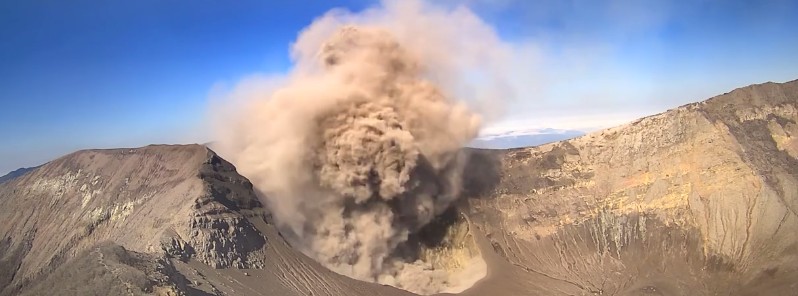Eruptive activity resumes at Costa Rica’s Turrialba volcano

The eruptive activity at Costa Rica's Turrialba volcano has resumed over the weekend with constant vapor, gas and ash explosions.
UCR's National Seismological Network (RSN) volcanologist Mauricio M. Mora said that ash and vapor spewings of almost 500 m (1 640 feet) above the crater resumed on January 27, 2017.
The winds have blown towards the northwest, Mora said and added that parts of the Central Valley had been affected by the ashfall and sulfur smell.
A strong explosion was recorded at 16:30 UTC (10:30 CST) on Saturday, January 28, followed by another explosion at 14:46 UTC (08:46 CST) on January 29.
On January 22, the Washington VAAC reported that an ash plume from Turrialba rose to an altitude of 4 km (13 000 ft) a.s.l. and drifted E.
Access to Turrialba Volcano National Park is currently closed and a 2-km (1.2 miles) security parameter is in effect around the volcano. However, TicoTimes reported that groups of tourists have been entering the restricted area to observe the explosions.
Numerous explosions have occurred at Turrialba since it entered an active phase in October 2014 and OVISCORI experts noted that they found rocks up to 2 meters (6.5 feet) in diameter in the surroundings of the crater.
The current eruptive cycle started in September 2016.


Geological summary
Turrialba, the easternmost of Costa Rica's Holocene volcanoes, is a large vegetated basaltic-to-dacitic stratovolcano located across a broad saddle NE of Irazú volcano overlooking the city of Cartago. The massive 3340-m-high Turrialba is exceeded in height only by Irazú, covers an area of 500 sq km, and is one of Costa Rica's most voluminous volcanoes.
Three well-defined craters occur at the upper SW end of a broad 800 x 2200 m summit depression that is breached to the NE. Most activity originated from the summit vent complex, but two pyroclastic cones are located on the SW flank. Five major explosive eruptions have occurred during the past 3500 years. A series of explosive eruptions during the 19th century were sometimes accompanied by pyroclastic flows. Fumarolic activity continues at the central and SW summit craters. (GVP)
Featured image: Turrialba volcano on January 29, 2017. Credit: RSN

Commenting rules and guidelines
We value the thoughts and opinions of our readers and welcome healthy discussions on our website. In order to maintain a respectful and positive community, we ask that all commenters follow these rules.